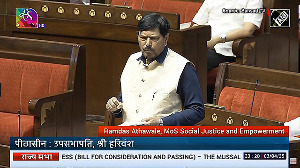'If the new rate is lower than your current rate, ask your bank to shift you to it.'
'This can be done by paying a fee of Rs 5,000 to Rs 6,000.'
Sanjay Kumar Singh explains the changes ahead.
Illustration: Uttam Ghosh/Rediff.com

If you are a home loan customer, you may have felt that your bank is quick to revise its interest rate upward in a rising rate scenario, but is slow to bring it down in a falling rate scenario.
This should change from April 1, 2019.
To ensure faster transmission of policy rates, the Reserve Bank of India has mandated that all new floating loans to retail customers and micro and small enterprises should be linked to external benchmarks.
Home loans given currently are linked to the marginal cost of funds-based lending rate (MCLR).
The MCLR was introduced on April 1, 2016.
Prior to that, the benchmark used was the base rate, and before that, the bank prime lending rate (BPLR).
"The existing benchmarks used by banks, such as MCLR, base rate, BPLR, etc are internal benchmarks primarily derived from banks' cost of funds. Banks enjoy a lot of discretion while setting them and they do not always move in line with broader interest rates," says Ratan Chaudhary, head of home loans, PaisaBazaar.com.
An internal study group of the RBI headed by Janak Raj had in its report found several problems with the way the MCLR functions and recommended the linking of loan rates to external benchmarks.
The new mechanism
From April 1, all new floating personal and retail loans (home and auto) will be benchmarked to one of the following external benchmarks: The RBI repo rate, the government's 91-day treasury bill yield, the government's 182-day treasury bill yield, or any other benchmark market interest rate produced by Financial Benchmarks India Pvt Ltd.
Banks will be allowed to set the spread over the benchmark at the inception of the loan.
Thereafter, it must remain constant throughout the life of the loan, unless the borrower's credit assessment undergoes a substantial change.
Also, each bank must adopt a uniform external benchmark within a loan category.
Greater transparency with greater volatility
With the introduction of an external benchmark, most experts expect greater transparency in the rate setting process.
"An external benchmark provides a simple, transparent and independent monitoring of interest rate movement for customers on their loans.
The interest rate movement will be directly linked to the market and shall be provided by independent authorities duly approved by the RBI," says Rohit Ranjan, head of secured lending, Citibank India, which already offers a home loan product linked to the three-month treasury bill rate.
While external benchmarks will be more responsive to interest rate changes, how fast the customer's home loan rate changes will depend on the reset period.
The RBI has yet to issue the final detailed guidelines.
"Transmission of rates will be quicker if the RBI, in its final guidelines, adopts the suggestion made by its internal study group on reducing the interest reset period to three months," says Chaudhary.
Other experts believe that rates may not be more volatile in the new regime.
"Just as in the MCLR system, banks may be allowed to set rate resets at three, six or twelve months," says Adhil Shetty, chief executive officer, BankBazaar.com
Faster rate transmission could have a flip side
Rates will rise faster in a rising rate scenario.
Customers's EMIs will not change every time the rate resets.
"Banks will first change the tenure. Only if that does not suffice, say, if a customer's loan tenure exceeds his retirement age, will his EMI change," says Aditya Mishra, founder and chief executive officer, SwitchMe, a digital home loan broker.
Closer link between spread and credit profile
The RBI has said that banks must keep the credit spread constant unless the risk assessment changes substantially.
This may result in the spread becoming more dependent on credit profile.
"In retail loans re-pricing may not happen at the level of the individual customer, but it could happen at the portfolio level," says Arun Ramamurthy, co-founder, Credit Sudhaar, which helps customers repair their credit profiles.
"If the risk associated with a cohort of customers changes, then the loan rate for that group could get re-priced," he adds.
One external benchmark for each loan category
Under the existing regime, banks publish MCLRs for various tenures, ranging from one day to one year.
Public sector banks like the State Bank of India and Bank of Baroda have linked their home loans to the one-year MCLR while some private banks allow a choice between their three-month and six-month MCLR.
Depending on which one the customer chooses, his home loan rate resets at that frequency.
"Perhaps the RBI felt that this was confusing customers regarding which option is better. So, in the new regime it has mandated one benchmark for every loan product," says Mishra.
What should you do?
According to experts, whether the new, external benchmark linked rates will be lower than the current MCLR-linked rates remains to be seen.
Much will depend on the benchmark each bank selects, and the spread it charges over it.
For instance, if a bank chooses the RBI repo rate (6.5%) as its benchmark and charges a spread of 2%, its home loan rate will be 8.5%.
SBI's home loan rates currently start from 8.75%.
Base rate and MCLR-linked rates are likely to continue.
Banks are not likely to automatically shift older customers to their new external benchmark linked rates.
"If the new rate is lower than your current rate, ask your bank to shift you to it. This can be done by paying a fee of Rs 5,000 to Rs 6,000," says Mishra.
If another bank's new external benchmark linked rate is significantly lower, calculate how much it will cost you to shift.
If the saving is significant, shift to it.
Keep an eye on your credit score.
"Make timely payments of dues and do not let your credit score deteriorate," says Renu Maheshwari, a Sebi-registered investment advisor, co-founder and principal advisor, Finscholarz Wealth Managers.
Adds Ramamurthy: "Banks price your loan depending on the cohort of customers you belong to. But if your credit score is high, negotiate for a lower interest rate."
| Interest rates on home loans above Rs 5 million | |
| Lender | Floating Interest Rate |
| State Bank Of India | Rs 5-7.5 million: 8.9-9.35%
Above Rs 7.5 million: 9-9.5% |
| ICICI Bank | Rs 5-7.5 million: 9.2-9.3%
Above Rs 7.5 million: 9.25-9.35% |
| Bank of Baroda | Rs 5-7.5 million: 8.65-9.65%
Above Rs 7.5 million: 8.65-9.9% |
| Punjab National Bank | Up to Rs 7.5 million: 8.7-8.9%
Above Rs 7.5 million: 8.75-8.95% |
| Union Bank of India | Up to Rs 7.5 million: 8.8%-9.15%
Above Rs 7.5 million: 8.85-9.45% |
| Axis Bank | 9.05-9.55% |
| HDFC Ltd. | Rs 5-7.5 million: 8.95-9.5%
Above Rs 7.5 million: 9-9.55% |
| Source: Paisabazaar.com | |













 © 2025
© 2025